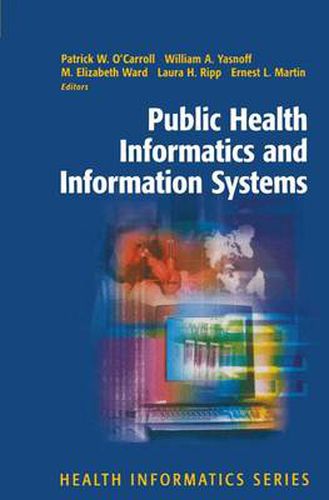Readings Newsletter
Become a Readings Member to make your shopping experience even easier.
Sign in or sign up for free!
You’re not far away from qualifying for FREE standard shipping within Australia
You’ve qualified for FREE standard shipping within Australia
The cart is loading…






This title is printed to order. This book may have been self-published. If so, we cannot guarantee the quality of the content. In the main most books will have gone through the editing process however some may not. We therefore suggest that you be aware of this before ordering this book. If in doubt check either the author or publisher’s details as we are unable to accept any returns unless they are faulty. Please contact us if you have any questions.
This book covers all aspects of public health informatics and discusses the creation and management of an information technology infrastructure that is essential in linking state and local organizations in their efforts to gather data for the surveillance and prevention. Public health officials will have to understand basic principles of information resource management in order to make the appropriate technology choices that will guide the future of their organizations. As the major topic at the American Medical Informatics Association’s (AMIA) spring congress in 2001, public health has moved into the spotlight, given the importance of implementing a population- based health approach and to addressing chronic health conditions. This book marks the first systematic effort to provide informatics principles and examples of practice in a public health context. In doing so, it clarifies the ways in which newer information technologies will improve individual and community health status. This book’s primary purpose is to consolidate key information and promote a strategic approach to information systems and development, making it a resource for use by faculty and students of public health, as well as the practicing public health professional. Chapter highights include: The Governmental and Legislative Context of Informatics; Assessing the Value of Information Systems; Ethics, Information Technology, and Public Health; and Privacy, Confidentiality, and Security. Review questions are featured at the end of every chapter. Aside from its use for public health professionals, the book will be used by schools of public health, clinical and public health nurses and students, schools of social work, allied health, and environmental sciences. Drs. O'Carroll and Yasnoff are public health specialists at the Centers for Disease
$9.00 standard shipping within Australia
FREE standard shipping within Australia for orders over $100.00
Express & International shipping calculated at checkout
This title is printed to order. This book may have been self-published. If so, we cannot guarantee the quality of the content. In the main most books will have gone through the editing process however some may not. We therefore suggest that you be aware of this before ordering this book. If in doubt check either the author or publisher’s details as we are unable to accept any returns unless they are faulty. Please contact us if you have any questions.
This book covers all aspects of public health informatics and discusses the creation and management of an information technology infrastructure that is essential in linking state and local organizations in their efforts to gather data for the surveillance and prevention. Public health officials will have to understand basic principles of information resource management in order to make the appropriate technology choices that will guide the future of their organizations. As the major topic at the American Medical Informatics Association’s (AMIA) spring congress in 2001, public health has moved into the spotlight, given the importance of implementing a population- based health approach and to addressing chronic health conditions. This book marks the first systematic effort to provide informatics principles and examples of practice in a public health context. In doing so, it clarifies the ways in which newer information technologies will improve individual and community health status. This book’s primary purpose is to consolidate key information and promote a strategic approach to information systems and development, making it a resource for use by faculty and students of public health, as well as the practicing public health professional. Chapter highights include: The Governmental and Legislative Context of Informatics; Assessing the Value of Information Systems; Ethics, Information Technology, and Public Health; and Privacy, Confidentiality, and Security. Review questions are featured at the end of every chapter. Aside from its use for public health professionals, the book will be used by schools of public health, clinical and public health nurses and students, schools of social work, allied health, and environmental sciences. Drs. O'Carroll and Yasnoff are public health specialists at the Centers for Disease